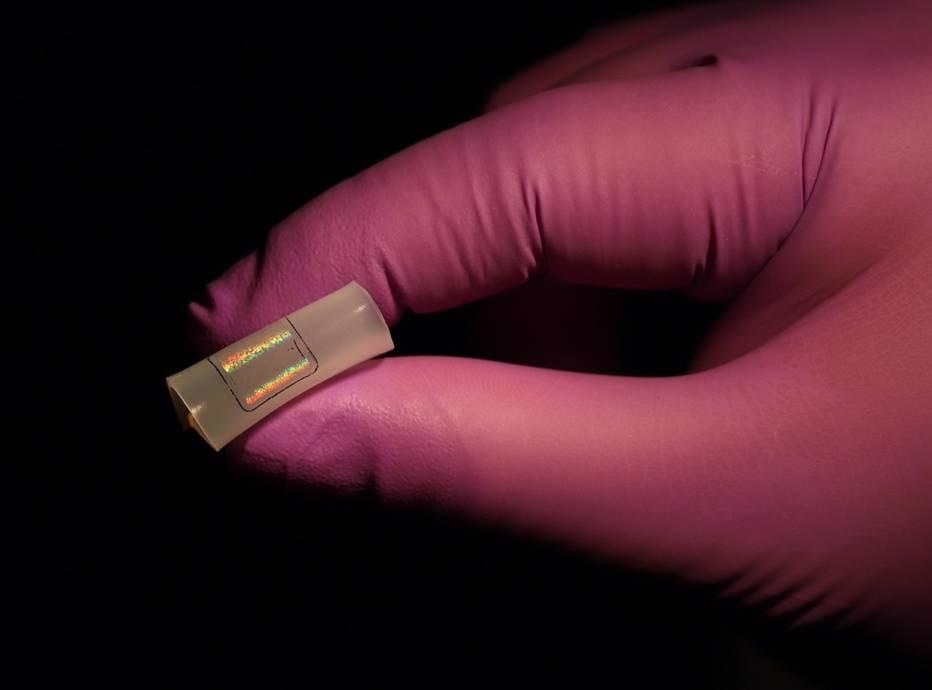Johns Hopkins University discovered that a COVID-19 sensor might improve viral testing by improving accuracy and speeding up a procedure that many people found frustrating during the epidemic.
 The sensor material can be placed on any type of surface, from doorknobs and building entrances to masks and textiles. Image Credit: Kam Sang Kwok and Aishwarya Pantula/Johns Hopkins University.
The sensor material can be placed on any type of surface, from doorknobs and building entrances to masks and textiles. Image Credit: Kam Sang Kwok and Aishwarya Pantula/Johns Hopkins University.
The researchers explain the sensor in a new article published in Nano Letters, which needs no sample preparation or operator experience and offers a significant benefit over present testing methods, particularly for population-wide testing.
Professor Ishan Barman, who worked with David Gracias, a professor of chemical and biomolecular engineering, “The technique is as simple as putting a drop of saliva on our device and getting a negative or a positive result.”
The key novelty is that this is a label-free technique, which means no additional chemical modifications like molecular labeling or antibody functionalization are required. This means the sensor could eventually be used in wearable devices.
Ishan Barman, Study Senior Author and Associate Professor, Mechanical Engineering, Johns Hopkins University
According to Barman, the new technique, which is not yet on the market, solves the shortcomings of the two most often used COVID-19 tests: PCR and fast testing.
PCR tests are extremely accurate, but they need time-consuming sample preparation, with results requiring hours or even days to analyze in a lab. Rapid tests, on the other hand, which check for the presence of antigens, are less efficient in finding early infections and asymptomatic cases and can result in incorrect results.
The sensor is almost as accurate as a PCR test and just as quick as a fast antigen test. The sensor achieved 92% accuracy in identifying SARS-COV-2 in saliva samples during the first testing, which is equivalent to PCR techniques. The sensor was also extremely effective in detecting the presence of other viruses, such as H1N1 and Zika.
Large-area nanoimprint lithography, machine learning and surface-enhanced Raman spectroscopy (SERS) are used to create the sensor. It may be utilized for mass testing on rigid or flexible surfaces in disposable chip configurations.
The Gracias lab created a large-area, flexible field enhancing metal-insulator antenna (FEMIA) array that is important to the technology. The saliva sample is put on the material and evaluated utilizing surface-enhanced Raman spectroscopy, which uses laser light to observe how molecules vibrate in the specimen being studied.
The method can quickly identify the presence of a virus, even if only minute amounts remain in the sample since the nanostructured FEMIA considerably enhances the infection’s Raman signal. Another significant feature of the technology is its use of modern machine learning algorithms to identify extremely tiny signs in spectroscopic data, allowing scientists to pinpoint the virus’s presence and concentration.
Label-free optical detection, combined with machine learning, allows us to have a single platform that can test for a wide range of viruses with enhanced sensitivity and selectivity, with a very fast turnaround.
Debadrita Paria, Study Lead Author and Post-Doctoral Fellow, Mechanical Engineering, Johns Hopkins University
From doorknobs and building entrances to masks and fabrics, the sensor material may be applied to any surface.
“Using state of the art nanoimprint fabrication and transfer printing we have realized highly precise, tunable, and scalable nanomanufacturing of both rigid and flexible COVID sensor substrates, which is important for future implementation not just on chip-based biosensors but also wearables,” added Gracias.
According to Gracia, the sensor might be used with hand-held testing equipment for quick checks in heavily populated areas such as airports or stadiums.
Our platform goes beyond the current COVID-19 pandemic. We can use this for broad testing against different viruses, for instance, to differentiate between SARS-CoV-2 and H1N1, and even variants. This is a major issue that can't be readily addressed by current rapid tests.
Ishan Barman, Study Senior Author and Associate Professor, Mechanical Engineering, Johns Hopkins University
The team is still striving to improve the technique and test it with patient samples. The intellectual property connected with it has been patented by Johns Hopkins Technology Ventures, and the team is looking for licensing and commercialization prospects.
Kam Sang (Mark) Kwok, a Chemical and Biomolecular Engineering graduate student; Piyush Raj, a graduate student; and Peng Zheng, a post-doctoral fellow in Mechanical Engineering, are among the authors.
The study was funded by the National Science Foundation’s Early-concept Grants for Exploratory Research (EAGER) program and the Director’s New Innovator grant from the National Institute of Health.
Journal Reference:
Paria, D., et al. (2022) Label-Free Spectroscopic SARS-CoV-2 Detection on Versatile Nanoimprinted Substrates. Nano Letters. doi.org/10.1021/acs.nanolett.1c04722.